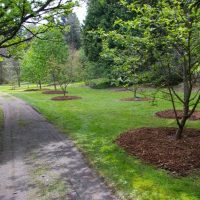Exciting News at Fiddleheads Forest School!
Listening and responding to the needs of our community is a cornerstone of the Fiddleheads philosophy. Sarah and I were absolutely astounded this year at the outpouring of interest our tiny school received. As word of the Fiddleheads Forest School spread, parents from all over the region took notice of the individualized attention we give to each child, our unique curriculum that thoughtfully integrates the specialized opportunities afforded by the environment to each student, and our remarkable forest grove classroom site where students develop a deep, mindful connection to their environment and to their peers.
Read moreCore Collection Highlight: Viburnum
Our Viburnum Collection is recognized as one of the top three national collections. Our taxonomic display currently is home to over 100 different kinds and 330 living specimens.
[Description references: “Viburnums — Shrubs for Every Season” by Michael Dirr.]
Here are a few samples of this diverse and ornamental shrub.
1) Viburnum carlesii var. bitchiuense Bitchu Viburnum
Wonderfully fragrant flowers in early spring.
Read moreExploding trees, now showing at your local Arboretum
March did not go out like a lamb, nor did it end with a whimper. No, this lion ended with a grand BANG!
A lightning strike from the massive thunderstorm that roared through Seattle yesterday was a direct hit on one of our largest trees in the Washington Park Arboretum.
A Grand Fir located in the Oak grove at the north end of the Arboretum was obliterated with one flash.
Glimpse into the Past – Thirty Years of Horticultural Outreach
When the Center for Urban Horticulture was established in 1980, one of the programmatic thrusts was to develop and carry out a comprehensive public outreach program.
Read moreGetting Low On Plants? Our Plant Sale Calendar Will Help!
Believe it or not, there are over 100 plant sales in the Pacific Northwest in April, including the FlorAbundance sale on April 25-26.
Read moreEncouraging Native Pollinators at the UW Farm
UW graduate student Nicolette Neumann Levi is looking for ways to bring more native pollinators to the UW Farm.
Read moreMarch Color Appears at the Washington Park Arboretum, Part II
1) Acer tegmentosum ‘Joe Witt’ Stripebark Maple
A small- to medium-size tree with distinct striped patterns along the bark and branches
Named for a former Washington Park Arboretum curator
Located in the Joe Witt Winter Garden
2) Berberis x media ‘Arthur Menzies’ Hybrid Mahonia
Multi-stemmed shrub with prominent winter flowers
Loved by hummingbirds as a source of winter nectar
Located in the Joe Witt Winter Garden
3) Ceanothus ‘Puget Blue’ California Lilac
A fast growing, medium-sized shrub
Known for small dark, evergreen leaves and purplish-blue late spring flower
Located along the fence in the Graham Visitors Center’s parking lot
4) Magnolia x kewensis ‘Wada’s Memory’ Hybrid Magnolia
Selected from a group of seedlings from nurseryman, Koichiro Wada
Known for large and abundant spring flowers
Two specimens flank Arboretum Drive near the Hydrangea Collection
5) Nothofagus antarctica ‘Puget Pillar’ Southern Beech
A medium-sized deciduous tree native to Argentina and Chile
Known for a somewhat fastigiate growth habit
Located along the shore near Duck Bay
April 2015 Plant Profile: Anemone nemorosa ‘Viridiflora’
A unique woodland charmer that’s easy to grow even in dry shade, Anemone nemorosa ‘Viridiflora’ is a charming spring ephemeral that’s a “must have” for the avid gardener.
Read moreCurrently flowering in the Washington Park Arboretum
In the old Nursery along Arboretum Drive there is a group of Chaenomeles cathayensis (Cathay or Chinese Quince) shrubs in full bloom. This cluster of three shrubs make for a huge display as they are about 15 ft. tall and 20+ ft. across. Covered in these lovely pinkish white flowers right now, they will bear very fragrant pear sized fruits in the autumn.
Read moreFarmer Reflection: Maya Garber-Yontz

The UW Farm. Oh what a place.
I was first introduced to the farm in August before my freshman year of college. I grew up with 18 raised beds in our backyard in Oregon that produced more vegetables than our family of four could use. My mom would fill baskets with the extra kale, peppers, tomatoes, lettuces, eggplants, cucumbers, and squash and send my brother and I off around the neighborhood to deliver the goodies.